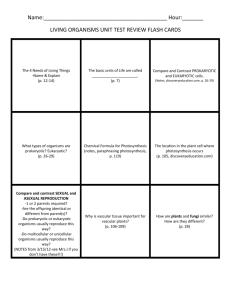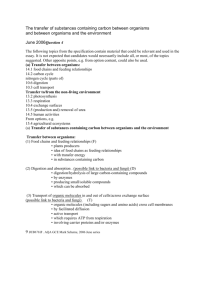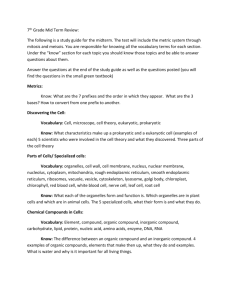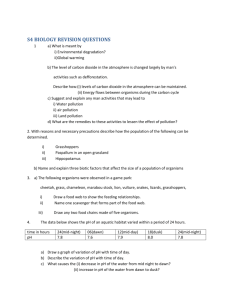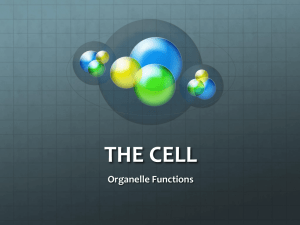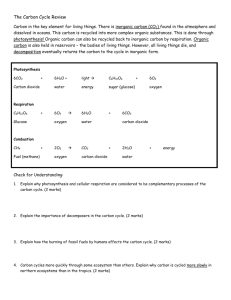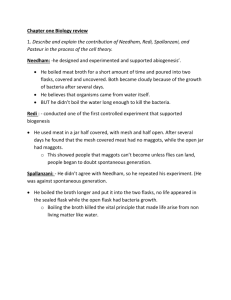Learning Intentions - VCE
advertisement
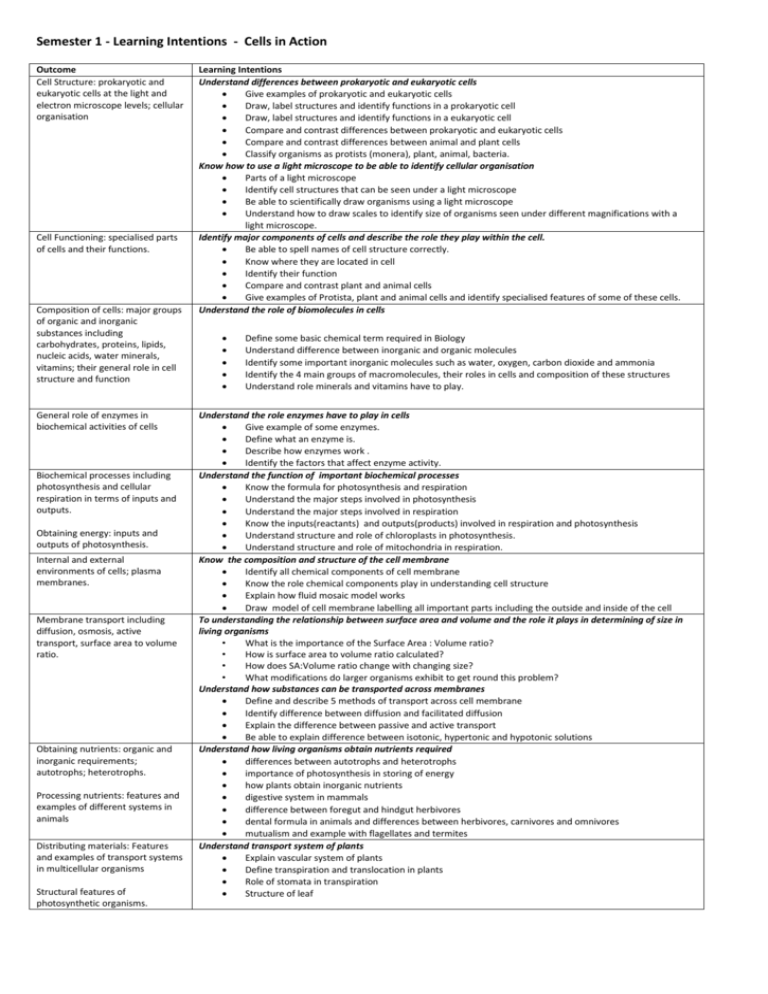
Semester 1 - Learning Intentions - Cells in Action Outcome Cell Structure: prokaryotic and eukaryotic cells at the light and electron microscope levels; cellular organisation Cell Functioning: specialised parts of cells and their functions. Composition of cells: major groups of organic and inorganic substances including carbohydrates, proteins, lipids, nucleic acids, water minerals, vitamins; their general role in cell structure and function General role of enzymes in biochemical activities of cells Biochemical processes including photosynthesis and cellular respiration in terms of inputs and outputs. Obtaining energy: inputs and outputs of photosynthesis. Internal and external environments of cells; plasma membranes. Membrane transport including diffusion, osmosis, active transport, surface area to volume ratio. Obtaining nutrients: organic and inorganic requirements; autotrophs; heterotrophs. Processing nutrients: features and examples of different systems in animals Distributing materials: Features and examples of transport systems in multicellular organisms Structural features of photosynthetic organisms. Learning Intentions Understand differences between prokaryotic and eukaryotic cells Give examples of prokaryotic and eukaryotic cells Draw, label structures and identify functions in a prokaryotic cell Draw, label structures and identify functions in a eukaryotic cell Compare and contrast differences between prokaryotic and eukaryotic cells Compare and contrast differences between animal and plant cells Classify organisms as protists (monera), plant, animal, bacteria. Know how to use a light microscope to be able to identify cellular organisation Parts of a light microscope Identify cell structures that can be seen under a light microscope Be able to scientifically draw organisms using a light microscope Understand how to draw scales to identify size of organisms seen under different magnifications with a light microscope. Identify major components of cells and describe the role they play within the cell. Be able to spell names of cell structure correctly. Know where they are located in cell Identify their function Compare and contrast plant and animal cells Give examples of Protista, plant and animal cells and identify specialised features of some of these cells. Understand the role of biomolecules in cells Define some basic chemical term required in Biology Understand difference between inorganic and organic molecules Identify some important inorganic molecules such as water, oxygen, carbon dioxide and ammonia Identify the 4 main groups of macromolecules, their roles in cells and composition of these structures Understand role minerals and vitamins have to play. Understand the role enzymes have to play in cells Give example of some enzymes. Define what an enzyme is. Describe how enzymes work . Identify the factors that affect enzyme activity. Understand the function of important biochemical processes Know the formula for photosynthesis and respiration Understand the major steps involved in photosynthesis Understand the major steps involved in respiration Know the inputs(reactants) and outputs(products) involved in respiration and photosynthesis Understand structure and role of chloroplasts in photosynthesis. Understand structure and role of mitochondria in respiration. Know the composition and structure of the cell membrane Identify all chemical components of cell membrane Know the role chemical components play in understanding cell structure Explain how fluid mosaic model works Draw model of cell membrane labelling all important parts including the outside and inside of the cell To understanding the relationship between surface area and volume and the role it plays in determining of size in living organisms • What is the importance of the Surface Area : Volume ratio? • How is surface area to volume ratio calculated? • How does SA:Volume ratio change with changing size? • What modifications do larger organisms exhibit to get round this problem? Understand how substances can be transported across membranes Define and describe 5 methods of transport across cell membrane Identify difference between diffusion and facilitated diffusion Explain the difference between passive and active transport Be able to explain difference between isotonic, hypertonic and hypotonic solutions Understand how living organisms obtain nutrients required differences between autotrophs and heterotrophs importance of photosynthesis in storing of energy how plants obtain inorganic nutrients digestive system in mammals difference between foregut and hindgut herbivores dental formula in animals and differences between herbivores, carnivores and omnivores mutualism and example with flagellates and termites Understand transport system of plants Explain vascular system of plants Define transpiration and translocation in plants Role of stomata in transpiration Structure of leaf Year 11 Biology Exam Preparation, Semester One, 2010 Terminology Plastid, nucleus, lysosome, mitochondria, endoplasmic reticulum, golgi apparatus, ribosomes, cytoplasm, cell membrane, vacuole, prokaryotic cell, eukaryotic cell, electron microscope, flagellum, cilia, cell theory, cell wall, cellulose, organelle, enzyme, active site, pH, denatured, protein, specific, catalyst, substrate, products, limiting factor, respiration, ATP, ADP, glucose, cristae, mitochondrion, matrix, photosynthesis, chloroplast, chlorophyll, turgid, flaccid, incisor, canine, premolar, molar, dental formula, diastema, epidermis, wilted, carbohydrate, polysacharrides, monosacharrides, starch, glycogen, amino acids, protein, lipids, phospholipids, cholesterol, fatty acids, glycerol, mineral ions (inorganic nutrients), fibre, cellulose, cellulase, digestion, absorption, omnivore, herbivore, carnivore, mutualism, vitamin, placental mammals, marsupials, monotremes, caecum, small intestine, villi, microvilli, foregut, hindgut, fermenter, stoma (stomata), autotroph, heterotroph, palisade mesophyll, spongy mesophyll, monotremes, marsupials, placentals, fermentation, flagellum, gizzard, diffusion, exocytosis, facilitated diffusion, active transport, osmosis, protein channel, phospholipid bilayer, glycoprotein. Focus Areas 1. Know the equations for photosynthesis and respiration. 2. Revise over the biology of termites and their relationship with protistans. 3. Review the structure of skulls and be able to interpret a dental formula and predict the diet of an unknown animal based on its dentition. 4. Review the role and structure of enzymes in cells. 5. Be able to relate the organelles present in a cell to the particular function of a cell. 6. Revise the structure of a leaf in Transverse Section and be able to state the function of each part. 7. Review the major biomacromolecules of living organisms (proteins, nucleic acids, lipids and carbohydrates) and their building blocks 8. Review other important biomolecules (water, vitamins, mineral ions) 9. Revise the structure of the cell membrane and the functions it performs. 10. Revise what elements make up biomacromolecules. 11. Revise the methods by which substances can cross the cell membrane. Reference Material 1. 2. 3. 4. 5. Selected worksheets from your Biozone Manual PowerPoints presented in class SACs that have been assessed during the semester. Wiki Heinemann Text Ch 1-7

